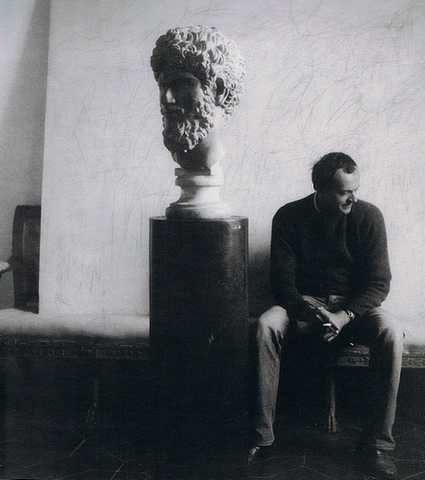
By Guest Blogger, Claire Sexton
Though as a teen he studied with Pierre Daura, Cy Twombly adopted his own peculiar style of skittery painting early on, after his first journey to Europe and North Africa. His early influences were artists like Kurt Schwitters, Jean Dubuffet, and Alberto Giacometti, who he was exposed to while studying at the Boston Museum School. After leaving Boston, Twombly met, influenced, and was influenced by many important artists at Washington and Lee University in Virginia, then at Black Mountain College in North Carolina. He was drafted into the army at age 25 and fittingly worked at cryptography, still painting and drawing at every opportunity. Twombly rose to prominence in the art world in the early 1980’s by serving as inspiration to a number of Neo-Expressionists, including Jean-Michel Basquiat, another controversial artist.
I first encountered his work on a trip to Europe where I happened across a special exhibition of paintings in a Munich museum. According to the wall labels, the works depicted a great naval battle, but even as a recent art history graduate, I didn’t get it. I could see a few boat-like objects on the canvasses, but at the time I thought, “It looks like a kid scribbled this!” It occurs to me now that the work for which he won the Scholastic Award must have been considerably more representative than the work for which he became known. Oh, to have a glimpse at that work!
Years later when I saw his Bacchus series at Gagosian Gallery, I was completely drawn in by the huge paintings. They were made with a beautiful orange-red paint on creamy-colored canvases, using a wide, soaked-and-dripping brush. A guard at the gallery told us how Twombly (then 77 years old!) created the paintings by climbing onto tall ladders. These were the paintings that would soon change my mind about his art.
The cities where artists choose to make their homes is a fascinating story, and Cy Twombly’s move to Rome in 1957 “as the art world shifted decisively in the other direction, from Europe to New York,” as Randy Kennedy’s Times obituary states, “was only the most symbolic of his idiosyncrasies.” There are plenty of artists who ignore the critiques of their work, but few, if any, are as influential and even spiritual as this Scholastic Awards alum.
About our Guest Blogger
Claire Sexton is a lover of art and the internet who appreciates when the two intersect. She currently consults with cultural organizations on social media outreach and digital marketing, after serving as the Communications Manager at the nonprofit art organization Art in General for three years. Originally from the great state of Texas, Claire studied Art History at the University of North Texas and moved to New York to attend NYU’s Visual Arts Administration master’s program. You can follower her on twitter @ClaireNicole and tumblr at http://clairenicole.tumblr.com/.
